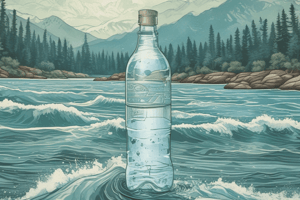Podcast
Questions and Answers
What percentage of bottled water sold in the US is filtered tap water?
What percentage of bottled water sold in the US is filtered tap water?
- Around 60%
- Over 70%
- Less than 50%
- Nearly 64% (correct)
What has driven the growth of the bottled water industry?
What has driven the growth of the bottled water industry?
- Lower prices compared to tap water
- Better taste compared to tap water
- Concerns about the quality of tap water (correct)
- Government regulations
What is the long-term solution to concerns about drinking water quality?
What is the long-term solution to concerns about drinking water quality?
- Reduce tap water consumption
- Require companies to conduct more tests
- Improve water infrastructure (correct)
- Increase bottled water sales
What is the WATER Act of 2019?
What is the WATER Act of 2019?
What is the main concern about bottled water contamination?
What is the main concern about bottled water contamination?
What is the percentage of the US population serviced by community water systems with at least one reportable health-based quality violation since 2013?
What is the percentage of the US population serviced by community water systems with at least one reportable health-based quality violation since 2013?
What is the recommendation regarding bottled water as a substitute for tap water?
What is the recommendation regarding bottled water as a substitute for tap water?
What is the best way to ensure the quality of your tap water?
What is the best way to ensure the quality of your tap water?
What percentage of bottled water sold in the US is filtered tap water?
What percentage of bottled water sold in the US is filtered tap water?
What is the long-term solution to concerns about drinking water quality?
What is the long-term solution to concerns about drinking water quality?
What is the purpose of the WATER Act of 2019?
What is the purpose of the WATER Act of 2019?
What is the main driver of the growth of the bottled water industry?
What is the main driver of the growth of the bottled water industry?
What is the cost of fixing the nation's water infrastructure annually over the next 20 years?
What is the cost of fixing the nation's water infrastructure annually over the next 20 years?
What is the percentage of the US population serviced by community water systems with at least one reportable health-based quality violation since 2013?
What is the percentage of the US population serviced by community water systems with at least one reportable health-based quality violation since 2013?
What is the purpose of the Consumer Confidence Report required by EPA regulations?
What is the purpose of the Consumer Confidence Report required by EPA regulations?
What is the main message regarding the use of bottled water?
What is the main message regarding the use of bottled water?
Flashcards are hidden until you start studying
Study Notes
Consumer Reports Investigation Raises Concerns About Bottled Water Quality and Safety
-
Americans spent $31 billion on bottled water in 2018, with the average American consuming 42 gallons.
-
Bottled water sales have risen in part due to concerns about the quality of tap water in places like Flint, Michigan, and Newark, New Jersey.
-
Nearly 64% of bottled water sold in the US is filtered tap water.
-
Safety inspections of water bottling facilities by the FDA have declined over the past 15 years.
-
The FDA requires companies to test the quality of their products, but the agency typically doesn’t conduct its own tests.
-
Companies aren’t required to make the results of their tests available to the public, and often don’t.
-
Some bottled water can be contaminated, as evidenced by recent tests that found PFAS chemicals in spring water sourced from a company in Massachusetts that supplied several bottled water brands, including Whole Foods’ 365 Spring Water and Ice Canyon Spring Water.
-
Tap water quality overall doesn’t appear to be getting worse, with the percentage of the US population serviced by community water systems with at least one reportable health-based quality violation staying below 10% since 2013.
-
The long-term solution to concerns about drinking water quality is to fix the nation’s water infrastructure, which would cost about $24 billion annually over the next 20 years, $7 billion less than what Americans spent on bottled water last year.
-
More than 5,000 community water systems have violated EPA regulations requiring them to provide customers with an annual Consumer Confidence Report, which spells out the quality of their tap supply.
-
The vast majority of Americans appear to have access to safe tap water, but some communities face real problems, such as those in Flint, Michigan, and Newark, New Jersey, where lead contamination crises have generated national headlines.
-
Bottled water should not be viewed as an acceptable substitute for tap water, but rather as a supplement to it, and the decision of what to use as your primary drinking water depends on where you live, the health of your municipal supply, and the pipes in your home.The Complicated Relationship Between Tap Water and Bottled Water
-
Bottled water is a booming industry, with sales surpassing soda in 2016.
-
Concerns about the quality of tap water, taste preferences, and perceived health benefits are driving the growth of the bottled water industry.
-
Government regulators don't test bottled water themselves, and bottled water makers aren't required to publish their own test results.
-
CR assembled a repository of test reports from bottled water brands and found that 6% of brands had a contaminant that exceeded state or federal limits.
-
Bottled water contamination exists, but consumers have limited access to information about it due to lax enforcement and reporting.
-
Oversight of tap water is more standardized and rigorous, with community water systems required to notify regulators within 24 hours of discovering a contaminant that poses an immediate health threat.
-
The Water Affordability, Transparency, Equity and Reliability (WATER) Act of 2019, now in Congress, would increase funding for drinking water and wastewater improvements.
-
Community water systems need to ensure that people have easy access to annual water quality reports, and municipalities can make it easier for people to refill their own water bottles.
-
Hudson, MA invested in a new filtration system that removed PFAS from its tap water, and testing last August didn't detect any PFAS in the town's water.
-
Filters that remove toxic substances, such as lead, are available for home use, as are pricier options like reverse osmosis systems.
-
State or local health departments might offer free water test kits.
-
Consumers should contact bottlers for a copy of their most recent quality report and avoid buying products from companies that won't share their water quality report.
Studying That Suits You
Use AI to generate personalized quizzes and flashcards to suit your learning preferences.





